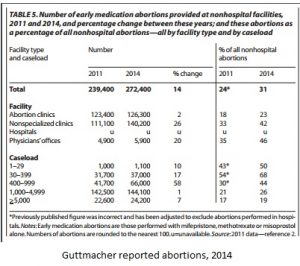Ever have questions about how data is collected on abortion in the United States? Over the years, we’ve received a number of inquiries regarding abortion statistics and reporting, and in this article, we hope to answer some of those questions:
1) Who reports abortion numbers?
There are two main organizations which gather data on national abortion numbers:
- The Centers for Disease Control’s Abortion Surveillance Report
- The Guttmacher Institute
2) Why does information on abortion from the CDC differ from the information from Guttmacher?
The CDC gathers information from states which require reporting; however, providing the data to the CDC is voluntary:
Each year, CDC requests tabulated data from the central health agencies of 52 reporting areas (the 50 states, the District of Columbia, and New York City) to document the number and characteristics of women obtaining legal induced abortions in the United States… In most states, collection of abortion data is facilitated by the legal requirement for hospitals, facilities, and physicians to report all abortions to a central health agency. These central health agencies then voluntarily report the abortion data they have collected through their independent surveillance systems and provide only aggregate numbers to CDC. Although reporting to CDC is voluntary, most reporting areas provide their aggregate abortion numbers.
According to the CDC, “states and areas voluntarily report data to the CDC for inclusion in its annual Abortion Surveillance Report” and “[t]here is no national requirement for data submission or reporting.”
In 2013, 47 reporting areas sent abortion data to the CDC, excluding five reporting areas (California, Florida, Maryland, New Hampshire, and Wyoming) that either did not report, did not report by age, or did not meet reporting standards. Because reporting is not mandatory, a complete number of abortions performed in the District of Columbia and New Jersey could not be obtained.
Guttmacher, which is the former “special affiliate” research arm of Planned Parenthood, gathers its figures from surveys which it claims it sends to all known abortion facilities, categorized by type. If there is no response from a facility, Guttmacher states that it follows up with a phone call or other means to gather the data. In some instances, Guttmacher will estimate numbers.
Because of this, Guttmacher tends to publish abortion totals that are higher than the CDC’s.
A summary of Guttmacher’s methodology on the 2014 reported abortion totals breaks down facility types this way:
- Abortion clinics are defined as nonhospital facilities in which half or more of patient visits are for abortion services, regardless of annual abortion caseload.
- 16% of facilities
- Accounted for 59% of abortions reported by Guttmacher
- Nonspecialized clinics are nonhospital sites in which fewer than half of patient visits are for abortion services.
- 31% of facilities
- Accounted for 36% of abortions reported by Guttmacher
- Of these:
- 38% were hospitals which performed fewer than 30 abortions per year
- Accounted for 4% abortions reported by Guttmacher
- Physicians’ offices are defined as facilities that provide fewer than 400 abortions per year and have names suggesting that they are private practices. Physicians’ offices that provide 400 or more abortions per year were categorized as nonspecialized clinics; because of their relatively large caseload, we assume that their service provision more closely mirrors that of a nonspecialized clinic.
- 15% of facilities
- Accounted for 1% of abortions reported by Guttmacher.
3) Are medication abortions reported?
Yes, according to Guttmacher:

Guttmacher Medication Abortions 2014
The survey instrument defined early medication abortions as procedures performed up to nine weeks’ gestation; to ensure that we captured all such abortions (and not just those done with mifepristone), we asked providers to identify the type of medication used, distinguishing among mifepristone (with misoprostol), methotrexate and misoprostol alone.
…In 2014, an estimated 272,400 early medication abortions were provided in nonhospital facilities, representing a 14% increase since 2011 (Table 5). Early medication abortions accounted for 31% of all nonhospital abortions, compared with 24% in 2011. Half or more of all abortions (50–68%) provided by facilities with annual caseloads of fewer than 400 procedures were early medication abortions.
The CDC’s report of abortion totals for 2013 states:
In this report, medical abortions and abortions performed by curettage are further categorized by gestational age. For medical abortion, early medical abortion is defined as the administration of medication or medications (typically mifepristone followed by misoprostol) to induce an abortion at ≤8 weeks’ gestation; medical abortion at >8 weeks’ gestation is defined as the administration of medication or medications (typically vaginal prostaglandins) to induce an abortion at >8 weeks’ gestation. For curettage, abortions are categorized as having been performed at ≤13 weeks’ gestation or at >13 weeks’ gestation because of differences in technique used before and after 13 weeks (23). Finally, because intrauterine instillations cannot be performed early in gestation, abortions reported to have been performed by intrauterine instillation at ≤12 weeks’ gestation are excluded from calculation of the percentage of abortions by known method type.
5) Are all abortions reported?
No.
According to the CDC’s report for 2013 abortion numbers:
Data were obtained every year during 2004–2013 from 47 reporting areas (excluding California, Louisiana, Maryland, New Hampshire, and West Virginia) and were used for trend analyses.
Guttmacher‘s report for 2014 states:
Undoubtedly, some facilities that provide abortion care, especially those with small caseloads, are not known to us and are excluded from our census.
It is important to note that neither the CDC nor Guttmacher count the use of emergency contraception such as Ella or Plan B, which state clearly on their label that they can prevent implantation, thus aborting a life that has begun.

Plan B website
From the 2015 Ella Label:

2015 Ella Label
While it is impossible to know who was or was not pregnant at the time emergency contraception pills were taken, it is plausible that in some instances, a life was ended after fertilization, when science states life begins.
However, it cannot be stated that every time EC’s are used, an abortion occurs.
6) How can I find out how many abortions are committed by my local Planned Parenthood or abortion facility?
- Abortion reporting is not required by federal law and reporting laws vary from state to state.
- To gather abortion numbers for your state, contact your local health department or the licensing agency of abortion facilities in your state.
- In some instances the county health department may gather abortion data by county.
- If the county does not have those numbers, contact your state health department or abortion licensing agencies.
- Reports of abortion numbers by facility are rarely published; however, Live Action News has documented some cases where this data is available. This can be viewed here.








